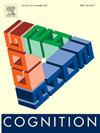无声手势中抽象范畴词序和谐的证据
IF 2.8
1区 心理学
Q1 PSYCHOLOGY, EXPERIMENTAL
引用次数: 0
摘要
跨范畴和谐是语言倾向于在不同类型的短语中使用一致的词头和依存词的顺序。例如,语言倾向于将动词和副词放在它们的依赖词之前(例如,英语中的“see the girl”,“to the store”)或之后(例如,土耳其语中的“the girl see”,“the store to”)。有人认为,和谐反映了对更简单规则的认知偏见:单个高级抽象规则比多个规则更容易学习,每种类型的头部和依赖都有一个规则(Culbertson和Kirby, 2016)。最近的实验工作支持了这一点,表明学习者更喜欢在不同的名义修饰语之前或之后一致地排列名词(例如Culbertson等人,2012,2020a)和不同类型的动词(Motamedi等人,2022),并将动词和名词的相对顺序概括为介词和名词的顺序(Wang等人,in press)。然而,这些研究在训练和测试刺激中都使用了完全相同的一组名词。这就留下了一种可能性,即参与者注意到表面的模式,即匹配短语中特定名词的位置。这会给人一种倾向于跨类别和谐的感觉,但不会反映任何关于类别对齐的事情,或者倾向于更少的抽象规则。本文描述了三个实验,旨在确定当使用表面模式的可能性被删除时,是否存在对立短语和动词短语之间跨类别和谐的认知偏见。本文章由计算机程序翻译,如有差异,请以英文原文为准。
Evidence for word order harmony between abstract categories in silent gesture
Cross-category harmony is the tendency for languages to use consistent orders of heads and dependents across different types of phrases. For example, languages tend to either place both verbs and adpositions before their dependents (e.g., ‘see the girl’, ‘to the store’ as in English) or after (e.g., ‘the girl see’, ‘the store to’ as in Turkish). Harmony has been argued to reflect a cognitive bias for simpler rules: a single high level abstract rule is simpler to learn than multiple rules, one for each type of head and dependent (Culbertson and Kirby, 2016). This has been supported by recent experimental work indicating that learners prefer to consistently order nouns either before or after different nominal modifiers (e.g. Culbertson et al., 2012, 2020a) and different types of verbs (Motamedi et al., 2022), and generalise the relative order of verb and noun to the order of an adposition and noun (Wang et al., in press). However, these studies all use the exact same set of nouns for both the training and testing stimuli. This leaves open the possibility that participants are noticing surface-level patterns, i.e., matching the position of specific nouns across phrases. This would give the appearance of a preference for cross-category harmony, but would not reflect anything about the alignment of categories, or a preference for fewer abstract rules. This paper describes three experiments that were designed to establish whether there is a cognitive bias for cross-category harmony between the adpositional phrase and the verb phrase which persists when the possibility of using surface-level patterns is removed.
求助全文
通过发布文献求助,成功后即可免费获取论文全文。
去求助
来源期刊

Cognition
PSYCHOLOGY, EXPERIMENTAL-
CiteScore
6.40
自引率
5.90%
发文量
283
期刊介绍:
Cognition is an international journal that publishes theoretical and experimental papers on the study of the mind. It covers a wide variety of subjects concerning all the different aspects of cognition, ranging from biological and experimental studies to formal analysis. Contributions from the fields of psychology, neuroscience, linguistics, computer science, mathematics, ethology and philosophy are welcome in this journal provided that they have some bearing on the functioning of the mind. In addition, the journal serves as a forum for discussion of social and political aspects of cognitive science.
 求助内容:
求助内容: 应助结果提醒方式:
应助结果提醒方式:


